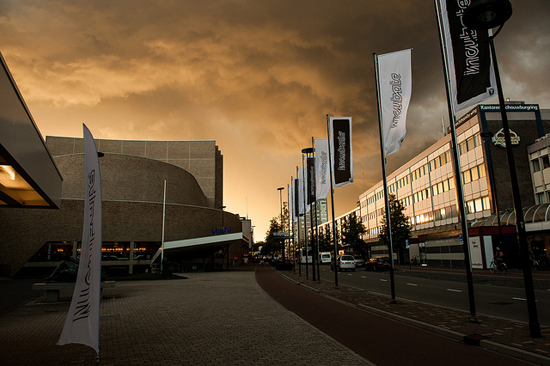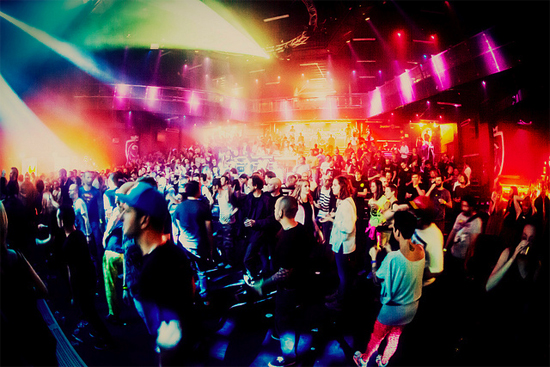The 24-stringed lute is a transportative device
Tilburg is a wonderfully grey town, an amalgamation of old villages that give it a strange sense of sprawl, a lack of focused centre. It sits in a flat landscape of fields, ditches, roads, and low industrial estates, far from the romantic prettified image of Holland depicted by the painters of old. There are no clogs or windmills here. The flat terrain seems to make the weather unpredictable as an English April, at one moment sunny, with a dull sheen on the paving bricks and walls, the next one of those persistent misty rains that soaks the trouser and chills the knee. It’s as if the North Sea is able to rattle in more easily here.
It’s much like the latter on Thursday night, where a packed Paradox sits before Jozef van Wissem who plays a twin-necked, 24-stringed lute. Tonight he plays a tranquil, bubbling set that, with his long straggling hair, has the feel of a musician of ancient times come in from the road to earn his warmth and shelter by playing a few songs. It’s not pretty ‘hei nonny nonny’, as Dutch might have it – Van Wissem sports a studded wristband, wanders the stage holding his instrument like an electric guitar, and his picking has a rough toughness, implying some kind of narrative, a description of place through dextrous sound. In feel, if of course not instrumentation or arrangement, I’m reminded of the powerful, evocative work of Richard Skelton, whose albums are as perfect a celebration of landscape as music has created in recent times. Its very visual too, more prosaically, you could imagine this soundtracking some trip out on the polder should Ben Wheatley ever make A Field In Holland. At the end, he wanders through the crowd playing, and disappears from the venue as if begging us to follow – pied piper of Tilburg. Luke Turner
Every town needs an Incubate
On Friday afternoon, a group of international visitors to Incubate, including myself, head to the council chamber of Tilburg’s town hall for a session with local councillors and city marketing people. John Robb is the chair, and sits up on the dais as if he’s just conducted a punk rock coup. Though few local representatives have bothered to turn up (something that makes the next day’s paper) the two hour discussion is a fascinating insight into the positive effect a festival like Incubate – and, indeed, metal bash Roadburn, also held here – can have on a town. The most similar place I can imagine in the UK might be somewhere like Stevenage or Hemel Hempstead, flat grey places built after the war with a sigh of ‘nothing special’. As Incubate founder Joost says, "we have a saying here that in Tilburg a tourist is the only attraction in town". Incubate does its best to change this – as well as bringing along one of the most diverse festival bills you’re likely to see, there’s also an impact on the local community, whether it’s theatre performances in the street, a bus tour of the city’s textile history, noise performances in a synagogue, or collaborations with a local farmer. Most important, though, is Make Tilburg Better, where local young people attended workshops on how they’d want to make their town and community a more pleasant place. British festivals, take note. Luke Turner

Wolf Eyes and Sky Needle bring the desert’s heat-haze
Wolf Eyes and their various solo projects mark some of the highlights of the week; a seething performance from the full group on Friday night drawing its power as much from restraint as aggression (a trait one wouldn’t have necessarily associated with the noise kingpins in the past), and a similarly pared-away, tense electronics set from Nate Young’s Regressions in Paradox. Entirely different, but of a similar oppressively dank atmosphere, are Australian collective Sky Needle. They’re an intriguing sight: a rag-tag group of misfits, several of whom look like they’ve fallen straight off the back of a pick-up truck in the middle of the outback, wringing out sour, off-kilter blues from a series of home-built instruments. There’s a guitar built from what looks like plywood, a short plank strung with metal strings, and a makeshift organ of sorts, built from a pair of footpumps you’d use to blow up an airbed. The music’s weird, lilting rhythms and the naturally unstable tunings of these instruments lend everything an ill, lurching sort of motion, as notes and chords slip in and out of sickly dissonance. That sensation is heightened by vocalist Sarah Byrne, who mumbles, moans and shrieks what sound like words, but never quite resolve themselves as anything more than vague verbal shapes. Everything feels heatsick and changeable, as if caught up in the depths of a fever dream or dehydrated desert hallucination. Far more so than the recorded incarnation on their new album Debased Shapes (a copy of which I pick up after the show) it feels pleasingly snide: ramshackle, sun-scorched blues to soundtrack your worst wilderness nightmare. Rory Gibb
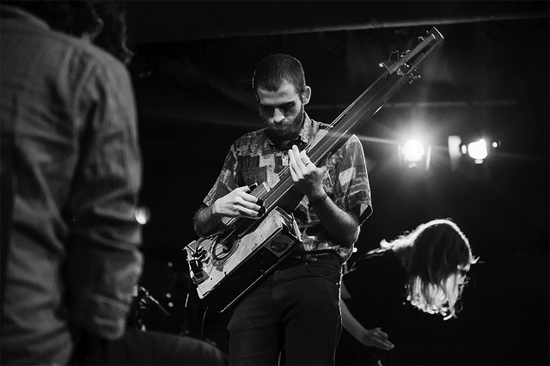
80s pop sounds best in a stone circle
Before they begin playing, Alexander Tucker and Daniel O’Sullivan’s onstage chit-chat lightens the air, with Tucker talking about his "retro-futurist cowboy boots" while trying to find a piece of rubber to steady his cello. It’s the sort of slightly bamboozled, eccentric feel that characterises their Glynnaestra LP, which has given The Quietus such sweet delight in 2013. With O’Sullivan on Akai MPK, Korg, violin and effects, and Tucker playing cello, bass, guitar and tapes, it’s a heady brew over which their vocals soar. ‘Protogenesis’ is like the choir of a catholic seminary on Mars, where raising grapes in biospheres had given communion wine hallucinogenic qualities. Live it sounds even more cosmic than on record. ‘Tilda Holds A Sword And Lilies’ begins with O’Sullivan violin and Tucker on autoharp, creating atmospheres reminiscent of Nico’s Marble Index, before rattling ancient loom rhythms and again, a weird pop chorus, voices that billow and blend like clouds in a fast sky. ‘The Ballad Of Roy Batty’ is also reconfigured, with Tucker adding some hi-end sunset guitar. I’m not quite sure whether to nick Rory’s scarf to suit the football montage vibe during its glorious chorus, or have a cry. A new song is possibly even more pop than anything on the album, like Tears For Fears in a sylvan, sun-dappled glade, and you get the sense that Grumbling Fur are only on the start of their wyrd and wonderful trip to explore the cosmic possibilities of what is actually rather accessible pop. Luke Turner
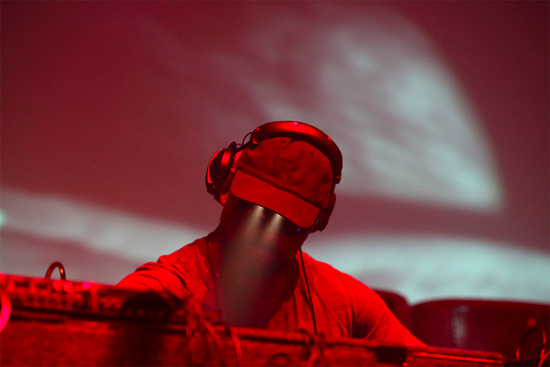
There’s nothing like a good bit of interpretive dance
There’s a high concentration of quality dance music at this year’s Incubate: the Friday night hosts Levon Vincent, Kowton and Kyle Hall (among others), while Saturday night in the main 013 venue is a themed celebration of ’25 Years of Acid House’. The scene is set for the weekend’s dancefloor activities, however, by an in-depth onstage interview with A Guy Called Gerald, hosted by The Wire‘s Derek Walmsley. It’s particularly insightful, delving into Gerald’s personal history and the Manchester scene, his understanding of acid house’s name ("like funk dipped into an acid bath … In goes Curtis Mayfield, out comes Adonis") and how his studio process has developed along with technology. One of the predominant stand-out themes that he returns to repeatedly, however, is the reciprocal relationship between dance music and the activity of dancers. Referring to the parties in Manchester he’d attend while still in the early stages of his career, he describes how sound system DJs would mix a variety of styles – funk, reggae, early house, soul, jazz fusion – but all with dancers in mind, allowing them to interpret the music in myriad show-off ways. Later, he describes imagining how dancers might move to music while he’s composing it, and why responsiveness is a crucial trait in a DJ and live performer – being open to reacting to your audience’s moves just as much as they’re reacting to your music.
After a slightly disappointing Friday night session – the usually claustrophobic pressure of Levon Vincent and Vatican Shadow frustratingly lost to the echo-ridden contours of the Hall Of Fame space – Gerald’s Saturday night set illustrates his philosophy in action. He’s been asked to return to an older style of set for the acid house night in 013, and so he’s playing entirely off hardware. His performance is striking for several reasons. Foremost, how open-ended it is; its slow and warm throb opening up possibilities for many different styles of dance, from the appreciative head-nodders near the back of the room, to my awkward, twitchy flailings, to full-scale loose-limbed mania down at the front. The difference between Gerald and acid originator DJ Pierre, who plays immediately afterward, couldn’t be more dramatic: the latter’s set takes the signifiers of Chicago house and steroid pumps them to grotesque extents, like ’80s acid-dipped funk retooled for attention-deprived EDM kids. House’s ostensible focus on perpetual groove and momentum is stripped away to a series of towering 32-bar crescendos and unsatisfying drops, while the 303 squiggle is an overbearing, ever-present headache, scrabbling maniacally up and down the register. It’s odd, considering his history and the amount of great music he’s put his name to, but where Gerald’s supple set beckons you to dance in any number of ways, Pierre’s is frustratingly rigid – he demands that you move, but provides only one fixed avenue along which to do so.
Gerald’s interpretation of the notion of acid is broader, too, matching his statements the previous day – rather than strafe his music with overdriven 303 splatter, that machine’s presence is subtly threaded through the mix, its telltale percolations strung slender between beats like ectoplasm. His set is noticeably contemporary in texture and feel – thanks in part to many young artists becoming interested in live performance on old and analogue hardware – but being just as musically and emotionally nuanced as the best of the new generation, it serves as a snub to technological fetishism. A reminder that, as Moodymann put it in a RBMA interview a few years back, it ain’t what you got – it’s what you do with what you have.
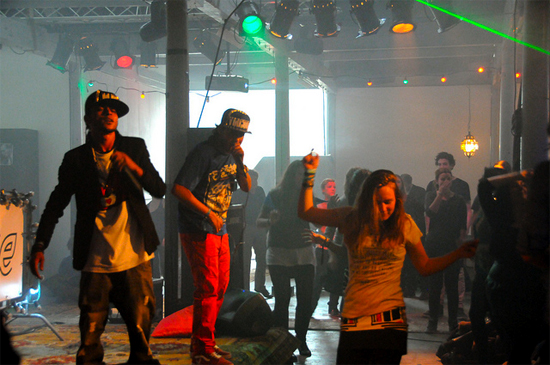
That’s a phrase that springs to mind again while attending the Electro Chaabi Wedding, a special event hosted by Incubate that’s invited along two star MCs from Egypt’s growing electro chaabi scene – Sadat and Alaa Fifty Cent – for an extended daytime performance. Quietus editor John Doran and Incubate co-director Joost Heijthuijsen traveled to Cairo near the beginning of this year to report on the sound (resulting in a fascinating series of features which you can read here), and this is one of the first times any of the scene’s protagonists have made it to Europe. Barely older than 20 and decked out in full hip hop regalia (chains, jewel-studded baseball caps), the duo – flanked by a DJ – bubble with energy, the music and their pin-sharp traded raps pouring from the stage and inciting a small crowd to sweat their residual hangovers out. Again, this music is all about dancing, and allowing dancers to follow the rhythms as they will: the artists’ entourage of friends and tour manager cluster down at the front, showing off all manner of competitive moves – twisted hips and arched backs, coiled arms, body pops and knees bent backwards to the ground – that put the stiff limbs and head-bobs rocked by most of the European members of the audience to shame.
"It’s what you do with what you have"? These guys have everything at their fingertips, or at least a decent facsimile of it. With the opening up of internet channels, young working class Egyptians have gained access to an array of cracked music softwares, allowing electro chaabi to draw all manner of ideas and sonic quirks into the mix. The reedy drone of traditional chaabi wedding music is present as a buzzsaw electronic whine, threaded through with dramatically autotuned vocals and overtly synthetic melodic lines. Hip hop’s swagger is present predominantly in the MCs themselves, who act as hosts and focal points, while their lyrics – I’m told – discuss subjects ranging from the personal to implicit social commentary. Without the ability to understand what they’re saying, my focus is drawn squarely to the fluid textural and rhythmic aspects of the music, which possess something of dancehall’s infectious low-end strut ‘n’ bounce and a sing-song-y metallic rattle that carries energy through the high end. That basic framework is scrambled with an almost junglist taste for interference – brief interruptions in momentum usher in flurries of pitchshifted, breakbeat-like drums, while around weight-bearing structural elements weave intricate spirals of additional percussion, offering new trajectories for willing limbs to follow. It sounds like a fusion of many styles I’ve heard before but simultaneously not quite akin to any of them, and its energy is irresistible: it’s not even lunchtime and I’m coated in a sheen of sweat that clings for the rest of the day. Rory Gibb
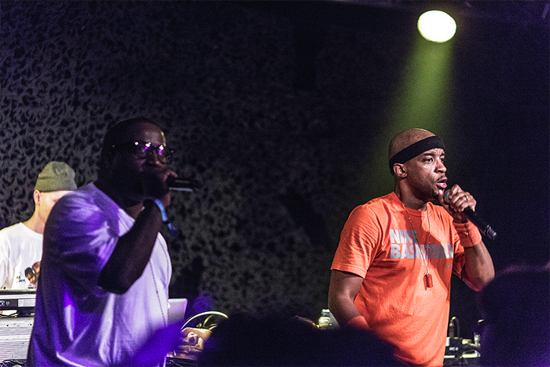
Masta Ace lives up to his name
Over at Hall Of Fame’s second room, the 8.6 Stage, it turns out that Masta Ace is running spectacularly over time. Even though he’s not showing signs of letting up anytime soon, it’d be hard to argue with the guy. When we arrive, he starts into ‘Take A Walk’ from his out-of-print but soon to be reissued 2001 LP Disposable Arts, and the sheer energy that Ace, backed up by regular associate Stricklin, brings to the room turns out to be the ideal remedy to Mayhem’s slightly underwhelming performance earlier. The track’s a, well, ace, timeless meld of hooky sample over vintage beats.
It takes a certain type of arrogance, albeit an endearing one, to be overrunning your slot at one festival and then list the line-up of another festival you’ve previously played as a means to name checking an artist you’re about to cover. But when said artist is Rakim and the track is ‘I Know You Got Soul’, playing heavy on M|A|R|R|S’ ‘Pump Up The Volume’ chorus, we’ll give Ace the benefit of the doubt. He and Stricklin trade lines with deft showmanship, before that chorus returns over and again, Ace commanding the room with the confidence of a veteran. He closes by casting an eye to the past, flashing some trademark humour – "I’ve been making records since 1988 – finally made it to Tilburg" – and delivering a closing trio of ‘I Did It’, ‘Good Ol Love’ and ‘Beautiful’. Sure, his and Stricklin’s call to the crowd to put "hands in the air for love" might cause some of Incubate’s more dark-hearted attendees to wince, but the addition of Ace to the bill was a master stroke by the festival, leavening the ferociously stern metal and techno with some necessary grandmaster hip-hop.
Dublin MC Rejjie Snow may want to take a few notes from Ace, in fact. As musically astute as Snow’s recent Rejovich EP was, his Sunday evening set saw Snow taking to the stage so baked he’d practically melted. Though he pulled through with the verses, it was the in-between track talk that suffered, especially a doomed attempt to thank his followers: "It’s all about the fans man. Just want to say… Nah… Just drop the track". Less of Amsterdam’s finest for you, sir. Laurie Tuffrey
Pete Swanson brings glorious destruction
Pete Swanson has one of the best Indian Chief faces you can see outside of an Immortal concert. Y’know the one, the ‘Oof’ face, lips turned down into a expression of pure concentration that radiates sadistic intent. Like a Mongol warlord or a scheming super villain who’s just bent the Golden Gate Bridge in half. And it is totally deserved. His short, brutal set is the audio equivalent of being attacked by a horde of flesh eating metal wasps. Containment tanker sized bursts of static shake themselves loose from the speakers and crash messily into the audience gathered around him on the venue floor, while simple pummelling backbeats, seemingly harnessed from totally arrhythmic elements and forced into propelling the whole glorious mess along like tigers pulling a garbage chariot, stop everything from collapsing into a tangled heap. At first the audience seem a bit stunned; I notice some nervous giggling and a few heads shaken in disbelief, but then as the set goes on – as it becomes apparent that the guy is JUST NOT GOING TO STOP – the audience begin to lose themselves in the sheer hellish miasma and the whole room ends up resembling the party at the end of the world that the music would so aptly soundtrack. It’s glory-geddon, man. It’s beautiful. Mat Colegate

You will like East India Youth when he’s angry
There’s nothing like a bit of organisational disarray to get the blood up: as well as Masta Ace overrunning, the bite is all but taken out of Vatican Shadow’s militant industrial cuts by paltry volume levels. Back in the smaller room and closing the hip-hop leg of the night, DJ Sueside somewhat rubs salt into the wound of the much-delayed schedule, spinning discs apace as if there just weren’t six further acts to go on.
First of those is East India Youth, at the time exploring the outer stages of sleep deprivation, and with the hunger in his eyes of a man who wants to simply do the job and be done with it. To be fair, EIY’s William Doyle does see the funny side of a well-intentioned but subtly flawed introduction from Sueside: "Give it up for – what’s your name? What? Give it up for East Indian Youth!" And, irrespective of the delays, and the soundman’s bizarre decision to dedicate his time to assembling a turntable onstage for the most part of the set, Doyle plays on and, up against it, turns in one of his best live shows I’ve seen. The erstwhile familiar terrain of ‘Glitter Recession’, ‘Dripping Down’ and ‘Heaven, How Long’ is skewed sonically by the mis-mix of the PA, but this ends up revealing new elements within the tracks, leaning towards a harder, more industrialised edge, with the latter extended by a brilliant, coruscating loop of the vocal chorus. For a moment, it looks like Doyle is going to pull the set short, the beginning of closer ‘Hinterland’ misfiring, but he perseveres.
And thankfully so: by now, his keyboard’s failed and Doyle hammers it against the table. If its final cries seeped through the USB port and added into the track, it’s hard to tell, but ‘Hinterland’, a majestic sprawl of a techno banger on record, became gloriously expansive. The glitchy loops and gentle washes fall into line, building relentlessly to the midway climax, when Doyle pulls everything out bar the fuzzy spasm of synth – then does it again – after which the juddering beats become almost nihilistically propulsive, driving towards a cataclysmic ending, Doyle ekeing out every shred of digital noise. Whether or not his equipment, or the soundman’s sense of pride, is still intact, we can’t say, but on what should’ve been a bad night, he pulls off a set that leaves people not only exhausted but joyously shell-shocked. Laurie Tuffrey
It’s important to step out of your comfort zone
In life, as in art and music and almost anything else you could care to name, it’s easy to remain comfortably lodged in your own niche, instead of taking the effort to head elsewhere. Spending the bulk of my time listening to electronic and dance music sometimes feels like ushering in the gradual onset of either mania or brain-rot. So it’s enjoyable, if not essential, to take the time to step out of that space and listen to music that you can’t immediately decode. It makes for a perhaps slightly purer listening experience, where lack of knowledge prevents you from automatically projecting narratives or associations upon what you’re hearing. Jazz tends to tick that box for me anyway, but Fire! are particularly difficult to place. The trio’s performance at Paradox – the jazz club in which much of this week’s best music is hosted – is by degrees restrained and volatile, cutting intuitively between styles.
They open in near-silence. Mats Gustafsson wrings out a series of electronic scratches and squiggles from a small tabletop set-up of oscillators and effects, while Andreas Werliin’s drumming escalates to gleefully feral, thrashing back and forth across his kit in bursts of arrhythmic clatter like a marionette with its strings cut to differing lengths. What initially feels like particularly arcane free jazz resolves into a taut krautrock-ish throb, with bass and keys from Gustafsson building to crescendo. And then, inevitably, the sax enters – a huge thing hewn of stained, ancient-looking metal – and sat about six feet away from Gustafsson he’s all physical exertion, veins bulging bright red, tearing out ragged, sustained peals that press violently upward, as if seeking to crash through whatever glass ceiling is holding them down.
The same pattern recurs throughout the set but in a different manner each time, with periods of exploratory downtime abruptly resolving, with the tick of a hi-hat, into a punkish, propulsive thrash that’s practically danceable (and, indeed, there are plenty of people lining the back of the room doing their best). These shifts from formlessness to tight structure – which, as with the rest of the set, I presume are mostly improvised – serve to hammer home how carefully each member is listening to the others play. Whatever miniscule cues serve as directional indicators, they’re imperceptible to the audience, making the entire hour-long performance a thrillingly seamless affair. Rory Gibb
The stern must reinvent – and Cut Hands has the solution
For me, one of the best aspects of Incubate is their habit of booking artists from the industrial and EBM worlds that most UK festivals won’t go near. So last year we had Chris & Cosey, Consumer Electronics and Laibach, this year Cut Hands, Front 242 and Clock DVA. The former was due to play at the Paradox jazz bar but shifted venue at the last minute to the grimier surroundings of Extase. It was a wise move. I’ve not seen William Bennett in an ‘art’ venue before, but can imagine it’d frustrate, for this is hypnotic dance music of the highest order. Without the footage of voodoo rituals that often accompanies his sets, the music itself is given centre stage, and rightly so, for it seems that Bennett is in the process of further refining and defining Cut Hands’ sound, stripping it back to its core brutal, infectious metallic punch, like battling the liquid Terminator. Bennett sticks his tongue out and wobbles his head, his hugely celebratory Africa-derived techno whipping a room of happy, flailing limbs.
On the Sunday evening, Clock DVA appear at De NWE Vorst, a wooden floored arts space with a powerful PA – it’s a shame Vatican Shadow, whose set was stymied by sound so appalling you could have a conversation right in front of the speaker, didn’t play here. The duo look like an evil Pet Shop Boys in white boiler suits, Adi Newton in his brown-shaded aviators especially sinister. When his throaty, growled voice starts it takes a turn for the Laibachian and shivery, combined with squelch and grit EBM. On the second track, a pretty melody comes in and out of the tough noise, as though one was waiting nervously for a dominatrix in a room with a holiday programme playing on a telly in the corner. The digitising of what were originally a more abstract-sounding tape and synth outfit is what keeps this fresh: rather than industrial nostalgia, this feels contemporary, not a million miles from Samuel Kerridge and Silent Servant – over another rubber funk rhythm they steal brassy synth stabs you might normal have expected to hear over hardcore. It’s a long way from Front 242, over in the main venue. Here, they give a lesson on how not to evolve, burly men midlife crisis flashing torches and yomping around the place in selections from the bargain bins at biker and fetish stores. Luke Turner
There’s not an ounce of fat on Fat White Family
As is often the case with festivals, Incubate’s Sunday afternoon offers a particularly strong run of musical treats – due, I suspect, largely to accumulated tiredness across the course of the previous week switching off the background brain chatter, making it easier to focus in on listening. Following a scorching jazz club performance from Fire!, Fat White Family’s closing set at Cul De Sac is a good degree more shambolic. Which you might well expect, given that the band’s overall aesthetic, character and sartorial choices err on the, erm, chaotic side. Yet contrary to the darkened eyebags, the sinister glint in one or two bandmembers’ eyes and the tonsure freshly shaved into the middle of singer Lias’ long, clammy black locks (in tribute, apparently, to legendary garage rock combo The Monks), the uneven tone to their performance is not the result of the band’s sloppiness but an ongoing problem with the three onstage microphones, frequently rendering their shrieks jarringly inaudible.
By contrast, there’s not an ounce of fat on Fat White Family: neither around the waistbands of the bandmembers themselves, all of whom look like they could use a good hearty meal or three, nor in their playing, which is unerringly tight throughout, in spite of Lias’ wild, sweaty windmillings into his bandmates, the audience and himself. If looks are anything to go by the show ought to be a mess. Instead, the tracks from their Champagne Holocaust album become equally menacing and celebratory: a murky version of ‘Cream Of The Young’ the most compellingly wrong song of the festival; a simmering ‘Auto Neutron’, whose swampy climax is enough to make the entire audience feel unwashed and unwholesome, as if we’ve just been drenched in stagnant bogwater. Rory Gibb
